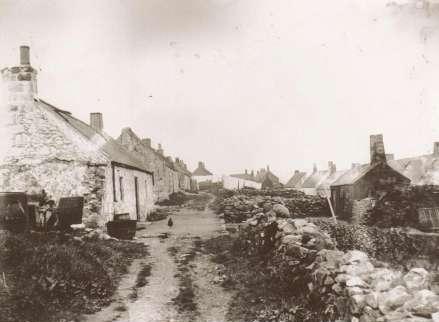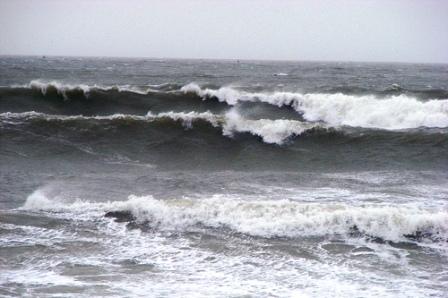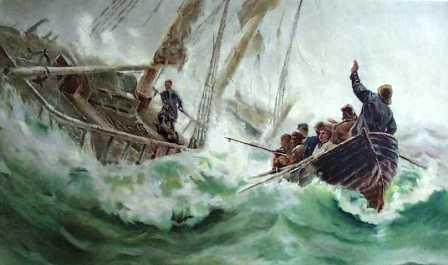
Wreck of the City of Aberdeen (1871) |
One of the earliest reports of a large shipwreck occurring in our area referred to the steamer, City of Aberdeen, which ran aground at Craigmarroin, half an hour after midnight on Friday 20th January 1871. Although the vessel was unsalvageable and ultimately sank there was no loss of life in this incident.
 Typical of the many shipwrecks along our coastline this
one occurred during the hours of darkness. The stretch of coast around
Portlethen in those days was dangerous on two fronts, firstly the nature
of the coast itself which is rocky, craggy and strewn with underwater
boulders. Secondly, any vessel approaching too close to shore would lose
sight of either of the lighthouses at Girdleness and Todhead, if that
occurred it would have been very easy to become disorientated.
Typical of the many shipwrecks along our coastline this
one occurred during the hours of darkness. The stretch of coast around
Portlethen in those days was dangerous on two fronts, firstly the nature
of the coast itself which is rocky, craggy and strewn with underwater
boulders. Secondly, any vessel approaching too close to shore would lose
sight of either of the lighthouses at Girdleness and Todhead, if that
occurred it would have been very easy to become disorientated.
The fact that the City of Aberdeen was aiming for the light of Girdleness from a southerly direction and then losing sight of it due to the headland of Findon Ness is a sure indicator that the vessel was too close to the shore for its own good. The usual course for vessels going north would have been to steer a course of about two miles from the land and by doing so the Girdleness light would remain in sight.
Immediately on striking Craigmarroin, several rockets were fired off from the vessel to attract the attention of anyone on shore however being a late hour most people were in bed. Preparations were made to launch the boats in order to land the crew and passengers (who included one lady who was travelling with her husband) but although the boats were lowered they did not attempt to land due to the rocky nature of the coast.
It wasn’t too long before the noise of the firing rockets, coupled with that of the vessel’s escaping steam, roused the local fishermen who, once they had ascertained the state of matters, hastened to the shore to determine what assistance they could render. A couple of boats were launched from the shore and on getting alongside the stricken vessel they discovered the passengers and crew in their own small boats which were then accompanied back to the shore and safety. The passengers were taken to the village where they were housed by various families and afforded good hospitality. Captain Marchant had remained onboard the City of Aberdeen but around 4.30am the ship went down a little and he was persuaded to come ashore.
The following day two tugs visited the wreck site to see if the vessel could be refloated but it was soon recognised that it would have been impossible to shift it whilst it still held its cargo. Two lighters were then sent for and eventually it’s cargo of tea, sugar, beer, glass-ware, hardware and other small merchandise was removed. Valuable time had been lost in this salvage operation and the longer the vessel remained in its precarious position the less chance there was of it being saved.
 At low tide it was noted that the keel was supported on a
submerged rock from under the foremast back nearly to the stern, the
bows being out of the water. At the same time several holes became
apparent, two on the starboard and one on the port side, not far above
the keel. There were also signs of several plates being indented and
ready to split.
At low tide it was noted that the keel was supported on a
submerged rock from under the foremast back nearly to the stern, the
bows being out of the water. At the same time several holes became
apparent, two on the starboard and one on the port side, not far above
the keel. There were also signs of several plates being indented and
ready to split.
The prospect of removing the vessel from the rocks when seen at low tide seemed very slight, even with calm weather. However her fate was sealed on Saturday night with the arrival of a fresh south easterly breeze blowing directly on to her broadside which was exposed to the elements. By Sunday morning the fore part of the vessel had parted at the foremast and had sunk and by that afternoon the aft portion remaining in view gradually broke up and disappeared from sight.
During that day the scene of the wreck was visited by a large number of people from the town and Captain Marchant was on hand all day to watch his charge sink from view, piece by piece. For days afterwards the coast was strewn for miles around with the wreckage of the 862 ton vessel.
As is the case with most shipwrecks there was a subsequent investigation and inquiry into the loss of the City of Aberdeen. What is surprising, given that the cause of the loss of the ship was down to poor navigation and misreading of certain lights, the only “punishment” dished out was to the First Mate. He ended up having his certificate suspended for a period of three months.
A painting of the "City of Aberdeen" on the rocks at Craigmarroin, Portlethen in 1871.
